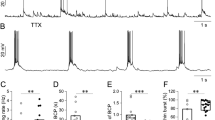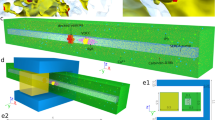Abstract
Voltage-sensitive Ca2+ channels (VSCCs) constitute a major source of calcium ions in dendritic spines, but their function is unknown. Here we show that R-type VSCCs in spines of rat CA1 pyramidal neurons are depressed for at least 30 min after brief trains of back-propagating action potentials. Populations of channels in single spines are depressed stochastically and synchronously, independent of channels in the parent dendrite and other spines, implying that depression is the result of signaling restricted to individual spines. Induction of VSCC depression blocks theta-burst-induced long-term potentiation (LTP), indicating that postsynaptic action potentials can modulate synaptic plasticity by tuning VSCCs. Induction of depression requires [Ca2+] elevations and activation of L-type VSCCs, which activate Ca2+/calmodulin-dependent kinase II (CaMKII) and a cyclic adenosine monophosphate (cAMP)-dependent pathway. Given that L-type VSCCs do not contribute measurably to Ca2+ influx in spines, they must activate downstream effectors either directly through voltage-dependent conformational changes or via [Ca2+] microdomains.
This is a preview of subscription content, access via your institution
Access options
Subscribe to this journal
Receive 12 print issues and online access
$209.00 per year
only $17.42 per issue
Buy this article
- Purchase on Springer Link
- Instant access to full article PDF
Prices may be subject to local taxes which are calculated during checkout






Similar content being viewed by others
References
Berridge, M.J. Neuronal calcium signaling. Neuron 21, 13–26 (1998).
Zucker, R.S. Calcium- and activity-dependent synaptic plasticity. Curr. Opin. Neurobiol. 9, 305–313 (1999).
Magee, J.C. & Johnston, D. A synaptically controlled, associative signal for Hebbian synaptic plasticity in hippocampal neurons. Science 275, 209–213 (1997).
Sabatini, B.L., Maravall, M. & Svoboda, K. Ca2+ signaling in dendritic spines. Curr. Opin. Neurobiol. 11, 349–356 (2001).
Nimchinsky, E.A., Sabatini, B.L. & Svoboda, K. Structure and function of dendritic spines. Annu. Rev. Physiol. 64, 313–353 (2002).
Svoboda, K., Tank, D.W. & Denk, W. Direct measurement of coupling between dendritic spines and shafts. Science 272, 716–719 (1996).
Kennedy, M.B. Signal-processing machines at the postsynaptic density. Science 290, 750–754 (2000).
Davare, M.A. et al. A β2 adrenergic receptor signaling complex assembled with the Ca2+ channel Cav1.2 Science 293, 98–101 (2001).
Yuste, R. & Denk, W. Dendritic spines as basic functional units of neuronal integration. Nature 375, 682–684 (1995).
Muller, W. & Connor, J.A. Dendritic spines as individual neuronal compartments for synaptic Ca2+ responses. Nature 354, 73–76 (1991).
Mainen, Z.F., Malinow, R. & Svoboda, K. Synaptic calcium transients in single spines indicate that NMDA receptors are not saturated. Nature 399, 151–155 (1999).
Cummings, J.A., Mulkey, R.M., Nicoll, R.A. & Malenka, R.C. Ca2+ signaling requirements for long-term depression in the hippocampus. Neuron 16, 825–833 (1996).
Jaffe, D.B. et al. The spread of Na+ spikes determines the pattern of dendritic Ca2+ entry into hippocampal neurons. Nature 357, 244–246 (1992).
Sabatini, B.L. & Svoboda, K. Analysis of calcium channels in single spines using optical fluctuation analysis. Nature 408, 589–593 (2000).
Sabatini, B.S., Oertner, T.G. & Svoboda, K. The life-cycle of Ca2+ ions in spines. Neuron 33, 439–452 (2002).
Svoboda, K., Denk, W., Kleinfeld, D. & Tank, D.W. In vivo dendritic calcium dynamics in neocortical pyramidal neurons. Nature 385, 161–165 (1997).
Catterall, W.A. Structure and regulation of voltage-gated Ca2+ channels. Annu. Rev. Cell Dev. Biol. 16, 521–555 (2000).
Brehm, P. & Eckert, R. Calcium entry leads to inactivation of calcium channel in Paramecium. Science 202, 1203–1206 (1978).
Budde, T., Meuth, S. & Pape, H.C. Calcium-dependent inactivation of neuronal calcium channels. Nat. Rev. Neurosci. 3, 873–883 (2002).
Oertner, T.G., Sabatini, B.S., Nimchinsky, E.A. & Svoboda, K. Facilitation at single synapses probed with optical quantal analysis. Nat. Neurosci. 5, 657–664 (2002).
Denk, W. & Svoboda, K. Photon upmanship: why multiphoton imaging is more than a gimmick. Neuron 18, 351–357 (1997).
Denk, W., Strickler, J.H. & Webb, W.W. Two-photon laser scanning microscopy. Science 248, 73–76 (1990).
Randall, A.D. & Tsien, R.W. Contrasting biophysical and pharmacological properties of T-type and R- type calcium channels. Neuropharmacology 36, 879–893 (1997).
Magee, J.C. & Johnston, D. Characterization of single voltage-gated Na+ and Ca2+ channels in apical dendrites of rat CA1 pyramidal neurons. J. Physiol. 487, 67–90 (1995).
Soong, T.W. et al. Structure and functional expression of a member of the low voltage-activated calcium channel family. Science 260, 1133–1136 (1993).
Tokumitsu, H. et al. KN-62, 1-[N,O-bis(5-isoquinolinesulfonyl)-N-methyl-L-tyrosyl]-4-phenylpiperazine, a specific inhibitor of Ca2+/calmodulin-dependent protein kinase II. J. Biol. Chem. 265, 4315–4320 (1990).
Kavalali, E.T., Zhuo, M., Bito, H. & Tsien, R.W. Dendritic Ca2+ channels characterized by recordings from isolated hippocampal dendritic segments. Neuron 18, 651–663 (1997).
Mermelstein, P.G., Bito, H., Deisseroth, K. & Tsien, R.W. Critical dependence of cAMP response element-binding protein phosphorylation on L-type calcium channels supports a selective response to EPSPs in preference to action potentials. J. Neurosci. 20, 266–273 (2000).
Bean, B.P. & Mintz, I.M. in Ion Channels (ed. Peracchia, C.) 199–210 (Academic, San Diego, 1994).
Czurko, A., Hirase, H., Csicsvari, J. & Buzsaki, G. Sustained activation of hippocampal pyramidal cells by 'space clamping' in a running wheel. Eur. J. Neurosci. 11, 344–352 (1999).
Ito, K. et al. Voltage-gated Ca2+ channel blockers, omega-AgaIVA and Ni2+, suppress the induction of theta-burst induced long-term potentiation in guinea pig hippocampal CA1 neurons. Neurosci. Lett. 183, 112–115 (1995).
Treiman, M., Caspersen, C. & Christensen, S.B. A tool coming of age: thapsigargin as an inhibitor of sarco-endoplasmic reticulum Ca2+-ATPases. Trends Pharmacol. Sci. 19, 131–135 (1998).
Nakai, J. et al. Enhanced dihydropyridine receptor channel activity in the presence of ryanodine receptor. Nature 380, 72–75 (1996).
Hille, B. Ionic Channels of Excitable Membranes (Sinauer, Sunderland, 2001).
Dolmetsch, R.E., Pajvani, U., Fife, K., Spotts, J.M. & Greenberg, M.E. Signaling to the nucleus by an L-type calcium channel-calmodulin complex through the MAP kinase pathway. Science 294, 333–339 (2001).
Kennedy, M.B., Bennett, M.K. & Erondu, N.E. Biochemical and immunochemical evidence that the “major postsynaptic density protein” is a subunit of a calmodulin-dependent protein kinase. Proc. Natl. Acad. Sci. USA 80, 7357–7361 (1983).
Ishida, A., Kameshita, I., Okuno, S., Kitani, T. & Fujisawa, H. A novel highly specific and potent inhibitor of calmodulin-dependent protein kinase II. Biochem. Biophys. Res. Commun. 212, 806–812 (1995).
Lledo, P.M. et al. Calcium/calmodulin-dependent kinase II and long-term potentiation enhance synaptic transmission by the same mechanism. Proc. Natl. Acad. Sci. USA 92, 11175–11179 (1995).
Shirke, A.M. & Malinow, R. Mechanisms of potentiation by calcium-calmodulin kinase II of postsynaptic sensitivity in rat hippocampal CA1 neurons. J. Neurophysiol. 78, 2682–2692 (1997).
Gao, T. et al. cAMP-dependent regulation of cardiac L-type Ca2+ channels requires membrane targeting of PKA and phosphorylation of channel subunits. Neuron 19, 185–196 (1997).
Westcott, K.R., La Porte, D.C. & Storm, D.R. Resolution of adenylate cyclase sensitive and insensitive to Ca2+ and calcium-dependent regulatory protein (CDR) by CDR-sepharose affinity chromatography. Proc. Natl. Acad. Sci. USA 76, 204–208 (1979).
Imredy, J.P. & Yue, D.T. Mechanism of Ca2+-sensitive inactivation of L-type Ca2+ channels. Neuron 12, 1301–1318 (1994).
Miller, S.G. & Kennedy, M.B. Regulation of brain type II Ca2+/calmodulin-dependent protein kinase by autophosphorylation: a Ca2+-triggered molecular switch. Cell 44, 861–870 (1986).
Lisman, J.E. & Zhabotinsky, A.M. A model of synaptic memory: a CaMKII/PP1 switch that potentiates transmission by organizing an AMPA receptor anchoring assembly. Neuron 31, 191–201 (2001).
Kullmann, D.M., Perkel, D.J., Manabe, T. & Nicoll, R.A. Ca2+ entry via postsynaptic voltage-sensitive Ca2+ channels can transiently potentiate excitatory synaptic transmission in the hippocampus. Neuron 9, 1175–1183 (1992).
Simon, S.M. & Llinas, R.R. Compartmentalization of the submembrane calcium activity during calcium influx and its significance in transmitter release. Biophys. J. 48, 485–498 (1985).
Bayer, K.U., De Koninck, P., Leonard, A.S., Hell, J.W. & Schulman, H. Interaction with the NMDA receptor locks CaMKII in an active conformation. Nature 411, 801–805 (2001).
Garaschuk, O., Yaari, Y. & Konnerth, A. Release and sequestration of calcium by ryanodine-sensitive stores in rat hippocampal neurones. J. Physiol. 502, 13–30 (1997).
Pologruto, T., Sabatini, B.L. & Svoboda, K. Flexible software for operating laser-scanning microscopes. BioMed. Eng. OnLine 2 (2003).
Watanabe, S., Hoffman, D.A., Migliore, M. & Johnston, D. Dendritic K+ channels contribute to spike-timing dependent long-term potentiation in hippocampal pyramidal neurons. Proc. Natl. Acad. Sci. USA 99, 8366–8371 (2002).
Acknowledgements
The authors thank T. Soderling for CaMKII*, T. Oertner, P. O'Brien and B. Burbach for help with experiments, and G. Buzsaki, A. Ghosh, R. Iyengar, R. Malinow and members of our laboratory for a critical reading of the manuscript. This work was supported by the Japan Society for the Promotion of Science (to R.Y.), the Burroughs Wellcome Fund (to R.Y. and B.S.), the Mathers and Pew Foundations, and the US National Institutes of Health (NIH).
Author information
Authors and Affiliations
Corresponding author
Ethics declarations
Competing interests
The authors declare no competing financial interests.
Supplementary information
Supplementary Fig. 1.
Relationship between calcium influx in response to a single action potential and spine volume. Spine volume was measured as in ref. 24. (PDF 191 kb)
Supplementary Fig. 2.
Schematic showing the signal transduction pathway causing DCC (see text for details). Red arrows, Ca2+ influx; black arrows, intracellular pathways. Dashed lines indicated putative interactions. (PDF 218 kb)
Rights and permissions
About this article
Cite this article
Yasuda, R., Sabatini, B. & Svoboda, K. Plasticity of calcium channels in dendritic spines. Nat Neurosci 6, 948–955 (2003). https://doi.org/10.1038/nn1112
Received:
Accepted:
Published:
Issue Date:
DOI: https://doi.org/10.1038/nn1112
This article is cited by
-
Stability against fluctuations: a two-dimensional study of scaling, bifurcations and spontaneous symmetry breaking in stochastic models of synaptic plasticity
Biological Cybernetics (2024)
-
The Impact of Sparse Coding on Memory Lifetimes in Simple and Complex Models of Synaptic Plasticity
Biological Cybernetics (2022)
-
Electrodiffusion with Calcium-Activated Potassium Channels in Dendritic Spine
Bulletin of Mathematical Biology (2021)
-
Pneumonia-induced endothelial amyloids reduce dendritic spine density in brain neurons
Scientific Reports (2020)
-
Monitoring intracellular nanomolar calcium using fluorescence lifetime imaging
Nature Protocols (2018)



